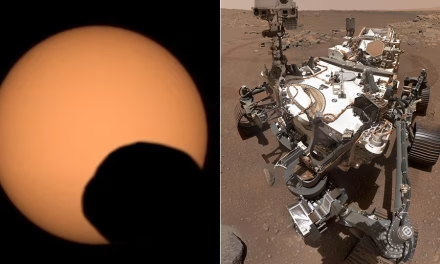When a total eclipse happens, the world changes — day suddenly becomes night, and the stars appear. A cold wind picks up and the birds fall silent. Time seems to stop. And this year, there will be a special visitor: Comet 12P/Pons-Brooks will appear not far from the eclipsing sun.
It’s rare that a bright comet approaches the Sun during a total solar eclipse, but that’s exactly what will happen this year. On Monday, April 8, 2024, Comet 12P/Pons-Brooks will be visible during the 2024 eclipse. This occurrence is called an Eclipse Comet. In the top image you can see the disk with a halo, that’s the eclipsed sun, and a bright “star”, the planet Jupiter to the left, and the comet with it’s long tail. (This image is a CG simulation of the event as it will be seen in the sky.)
Last year, observers across the U.S. witnessed spectacular celestial events, including a beautiful “ring of fire” eclipse last October 14th. That was a partial eclipse. This year on April 8, the moon will pass exactly between the Earth and the sun, completely blocking out the sun and causing a breathtaking total eclipse. The last time this happened in the U.S. happened in 2017, and it won’t happen again until August 23, 2044.

Amateur astronomer, astrophotographer, and longtime comet-lover Dave Weixelman from Nevada City, California, discovered that Comet Pons-Brooks would be near the eclipsed Sun this year during totality of the 2024 total solar eclipse. He did the calculations on his PC! Comet 12P/Pons-Brooks has a period just over 70 years, last seen in 1953, and possibly it’s first observation by humans was in the 14th century.
It was in 1883 that the comet first displayed an unusual characteristic. 12P/Pons-Brooks experiences intense outbursts when it can flare to 100 times its normal brightness! It’s already done so several times since it was spotted again in 2020, as it approached Saturn. No-one knows why, but a good guess is that frozen carbon monoxide and dioxide begin to evaporate as the comet approaches the sun, occasionally bursting to the surface. This could make Pons-Brooks extra bright as it approaches the sun.


Above is a simulation of the night sky that shows the position of the sun and planets on April 8, 2024. Below is the path of the eclipse across Mexico the United States and Canada.

Nicknamed the Devil Comet for its hornlike appearance, fans of interstellar spaceflight have also suggested the unusual shape of this large comet’s central coma (cloud) looks like the Millenium Falcon. (If the Falcon were hundreds of thousands of miles wide.)

Comets like 12P/Pons-Brooks are made up of an icy nucleus surrounded by a coma — a cloud of gas and dust. Water ice, along with frozen carbon dioxide, carbon monoxide, methane, and ammonia, make up most of it. Its classification as a cryovolcanic comet comes from the ice and gas jets that cause it to brighten. Comets are believed to be ancient remnants of the early solar system, rough snowballs of solar nebula that are still here billions of years later.
We’ll more news in April as the event itself approaches.
-30-
![]()
David Raiklen wrote, directed and scored his first film at age 9. He began studying keyboard and composing at age 5. He attended, then taught at UCLA, USC and CalArts. Among his teachers are John Williams and Mel Powel.
He has worked for Fox, Disney and Sprint. David has received numerous awards for his work, including the 2004 American Music Center Award. Dr. Raiklen has composed music and sound design for theater (Death and the Maiden), dance (Russian Ballet), television (Sing Me a Story), cell phone (Spacey Movie), museums (Museum of Tolerance), concert (Violin Sonata ), and film (Appalachian Trail).
His compositions have been performed at the Hollywood Bowl and the first Disney Hall. David Raiken is also host of a successful radio program, Classical Fan Club.













You must be logged in to post a comment.